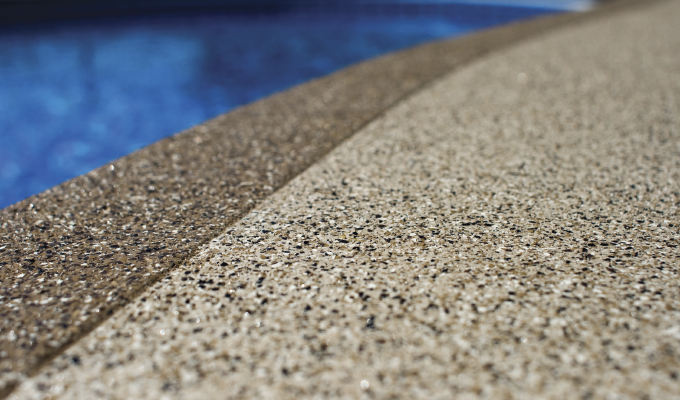Decorative concrete has gained popularity as a transformative element that revitalizes outdoor spaces, particularly in commercial construction applications. No longer seen as just a functional, utilitarian solution, decorative concrete now serves as a versatile canvas for architects and designers looking to create aesthetically pleasing, durable and cost-effective environments.
The adaptability of decorative concrete allows for the creation of unique, customized outdoor spaces that not only enhance visual appeal, but also meet the rigorous demands of commercial properties. From bustling plazas and stylish retail exteriors to inviting hotel courtyards and slip-resistant pool decks, decorative concrete offers exceptional design flexibility and performance.
BENEFITS IN COMMERCIAL APPLICATIONS
Known for its strength and durability, concrete has been a staple material used in construction for centuries. But with advancements in technologies and design, decorative concrete has evolved beyond its traditional role to encompass an array of techniques and finishes that enhance its visual appeal while retaining a high level of performance. By understanding the key benefits of decorative concrete, commercial construction contractors can make more informed decisions about its application.
Some of the biggest benefits of decorative concrete are its strength, longevity, and aesthetic versatility. When properly installed and maintained, it can withstand heavy use and harsh elements—making it ideal for high-traffic walkways, plazas, and pool decks. Decorative concrete offers endless design possibilities—including techniques like stamping, staining, polishing, and exposed aggregate—that can complement any architectural style or landscaping theme for a unique outdoor space.
Compared to natural stone or brick, decorative concrete can also be more affordable and easier to maintain, offering a high-end look at a fraction of the cost. These sealed surfaces resist stains, moisture, and UV damage, requiring only routine cleaning to remain pristine. This low maintenance helps to reduce long-term costs for commercial property owners and managers.
As an eco-friendly material, concrete contributes to sustainable building practices through its longevity and energy efficiency. Locally sourced materials and recycling potential add to these environmental benefits, helping commercial projects achieve sustainability goals. Decorative concrete also enhances safety in areas like pool decks and walkways with slip-resistance textures, such as exposed aggregate.
Yet another key benefit is its ability to add character to any outdoor space by mimicking natural materials like stone, brick, or wood, or by creating unique textures and patterns. An example of this is polished concrete, which can add a sleek, modern look to outdoor spaces.
Combining functionality with aesthetic appeal, decorative concrete is an ideal choice for a range of commercial applications. Below are five impactful ways to use decorative concrete:
PATIOS
Decorative concrete is often used to create inviting patios and outdoor living areas for properties such as hotels, restaurants, and office complexes. Stamped concrete—which involves imprinting patterns onto freshly poured concrete to replicate the appearance of materials like brick, slate, or tile—can offer a cost-effective alternative to natural materials. This technique enables intricate designs that enhance the ambiance and functionality of outdoor spaces.
POOL DECKS
Around swimming pools, decorative concrete provides both aesthetic appeal and safety. Textured finishes, such as exposed aggregate, enhance slip resistance and ensure a secure environment for guests. Additionally, using cool-touch concrete materials can keep the surface comfortable enough to walk on, even under the hot sun. These features are especially beneficial for commercial properties like resorts and recreational facilities.
WALKWAYS AND DRIVEWAYS
Decorative concrete can enhance curb appeal by transforming functional walkways and driveways into attractive features that unify a property’s landscaping and architecture. Stained concrete, for example, can offer a more organic, variegated look that enhances the natural beauty of concrete while providing exceptional durability and low maintenance.
GARDEN FEATURES
From retaining walls to decorative planters, concrete offers a versatile medium for creating custom garden features that blend seamlessly with natural surroundings. These elements can be designed to complement landscaping while providing functional benefits such as soil retention and plant support. Polished concrete, for example, can be used for sleek, modern planters and garden sculptures that add a touch of elegance to outdoor spaces.
PUBLIC SPACES
Parks, plazas, and commercial developments benefit from the durability and design flexibility of decorative concrete. Because they allow existing concrete surfaces to be rejuvenated with new textures, colors, and patterns, overlay systems are ideal for renovating worn-out or outdated concrete without the need for complete replacement. This technique can be used to create unique, inviting public spaces that withstand heavy foot traffic and environmental exposure.
ACHIEVING THE DESIRED LOOK
Employing the appropriate concrete mix, sealant, and installation techniques are all crucial to prevent cracking and ensure longevity with decorative concrete—especially in regions exposed to extreme temperatures and freeze-thaw cycles. Professional installation ensures the concrete is properly mixed, poured, and finished to achieve the desired look and performance.
Understanding the expected lifespan and performance characteristics of decorative concrete can also help commercial property owners and managers make more informed decisions about their outdoor investments. While decorative concrete is low maintenance in nature, periodic resealing may be necessary to preserve its appearance and protective qualities—particularly in high-traffic areas. Regular inspections and maintenance help to extend the lifespan of decorative concrete surfaces.
It’s also important to integrate decorative concrete into a cohesive design that complements existing landscaping, architecture, and other outdoor features. This requires careful planning and consideration for elements like color, texture, and scale to ensure a harmonious result.
Decorative concrete represents a fusion of artistry and functionality, offering limitless possibilities for enhancing outdoor spaces. Whether used for designing patios, driveways, or garden features, its versatility and aesthetic appeal make it a preferred choice in commercial construction.
About the Author
Rich Cofoid is a senior product and marketing manager at Euclid Chemical, a leading manufacturer of specialty concrete and masonry construction solutions. A 25-year industry veteran, Cofoid manages product marketing for the Increte line of decorative concrete products. His training sessions have been featured at several major industry events, such as World of Concrete, Concrete Décor Show, ASCC, ACI, and AIA. For more, visit www.euclidchemical.com.


